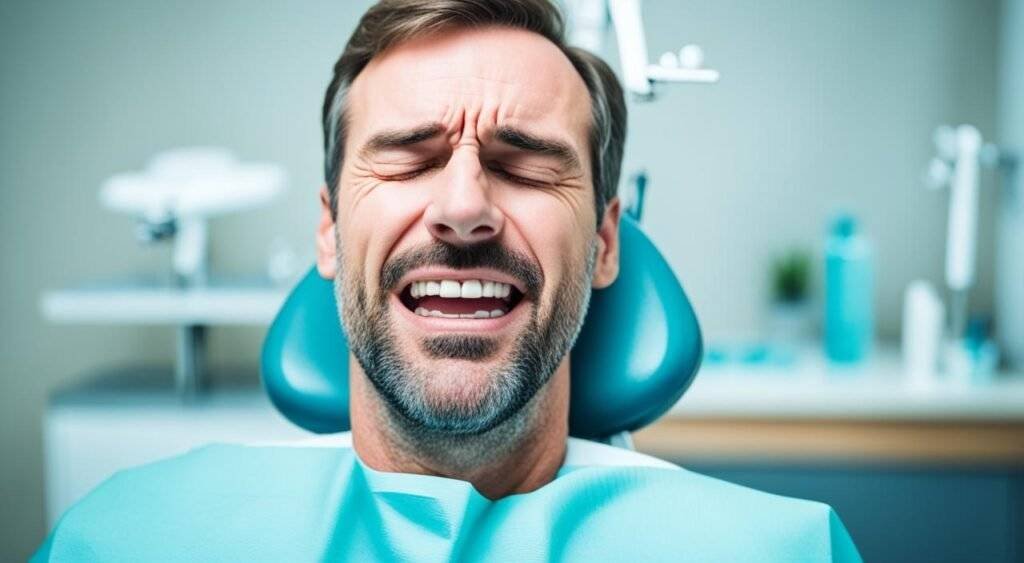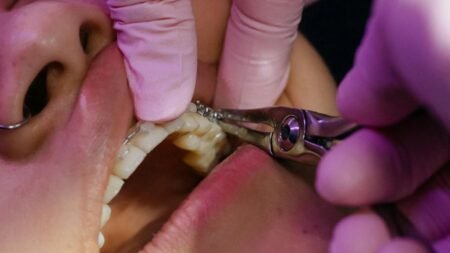Have you ever felt pain or sensitivity in a tooth under a dental crown? This can be worrying and make you wonder what’s causing it. What if finding relief was easier than you thought? Understanding the cause of this issue, especially when tooth pain under crown comes and goes, could help you feel better and avoid more problems.
Key Takeaways
- Tooth pain under a dental crown can come and go, indicating an underlying issue that needs attention.
- Common causes include tooth decay, infection, and an improperly fitted crown.
- Ignoring recurring tooth sensitivity can lead to more serious problems, such as nerve damage or tooth loss.
- A combination of home remedies and professional treatment can provide relief and address the root cause of the problem.
- Proper oral hygiene and regular dental checkups are essential for maintaining the health and longevity of a crowned tooth.
Understanding the Causes of Intermittent Tooth Pain Under a Dental Crown
Tooth pain that comes and goes under a dental crown can have several causes. One main reason is tooth decay or an infection under the crown. This happens if you don’t brush well or if the crown doesn’t fit right, letting bacteria in.
Tooth Decay or Infection
A dental crown covers the tooth you can see, keeping it safe from decay. But if the crown doesn’t fit well or if you don’t brush right, decay can still happen under it. This leads to bacteria buildup and an infection, causing pain and sensitivity.
Ill-Fitting Dental Crown
An ill-fitting dental crown can also cause pain. If it’s not in line with the tooth, it can rub on the gum or put too much pressure on the tooth. This is a big problem if the crown wasn’t made or put in right.
| Causes of Intermittent Tooth Pain Under a Dental Crown | Symptoms |
|---|---|
| Tooth Decay or Infection | Severe, throbbing pain Prolonged sensitivity to hot or cold temperatures Discoloration of the tooth Swelling or tenderness in the gums Presence of a dental abscess |
| Ill-Fitting Dental Crown | Intermittent, sharp pain when biting or chewing Sensitivity to pressure or touch Gum irritation or inflammation around the crown Feeling that the crown is “high” or doesn’t fit properly |

Fixing the cause of the pain under a dental crown is key to keeping the tooth healthy. Getting to the dentist quickly is important to find out what’s wrong and fix it.
The Risks of Ignoring Recurring Tooth Sensitivity Under Crowned Tooth
Ignoring tooth pain or sensitivity under a dental crown can lead to bigger problems. If you don’t fix the issue, it might get worse. This could mean more tooth damage, infection, or needing more dental work. It’s important to deal with any ongoing pain from a crowned tooth to avoid more issues and keep your mouth healthy.
The risks of not taking care of tooth sensitivity under a crowned tooth include:
- Tooth decay or infection spreading deeper into the tooth, potentially requiring root canal treatment or even tooth extraction
- Increased risk of the crown becoming loose or dislodged, leading to further damage to the underlying tooth structure
- Potential for the development of a dental abscess, which can cause swelling, pain, and even life-threatening complications if left untreated
- Increased likelihood of needing more extensive and costly dental procedures, such as a crown replacement or a dental implant, if the original crown fails
Not dealing with crowned tooth discomfort can have big effects on your health and well-being. It’s key to fix any ongoing sensitivity or pain under a dental crown quickly. This helps avoid risks and keeps your smile healthy and working right.
| Potential Complications | Consequences |
|---|---|
| Tooth decay or infection | Require root canal treatment or tooth extraction |
| Loose or dislodged crown | Damage to underlying tooth structure, need for crown replacement |
| Dental abscess | Swelling, pain, and potential for life-threatening spread of infection |
| Need for more extensive dental procedures | Increased cost and complexity of treatment, such as dental implants |
By understanding the risks of ignoring pain under a crown, you can act early to keep your mouth healthy. This helps you avoid the bad outcomes of not taking care of this common dental problem.

Tooth Pain Under Crown Comes and Goes: Diagnosing the Root Cause
If you’re feeling pain under a dental crown that comes and goes, finding the cause is key. A thorough dental check-up, including X-rays and a detailed bite analysis, can help. This is how you can figure out what’s causing the pain.
Dental X-Rays and Examination
Dental X-rays are vital for spotting problems that might be causing your pain. They can show decay, infections, or other issues that could be the cause. Your dentist will also examine you closely to find the exact problem. This could be a crown that doesn’t fit right or problems with the tooth underneath.
Bite Analysis and Occlusion Adjustment
Sometimes, the pain could be from how the crown fits and aligns with your teeth. Your dentist can check this with a bite analysis. If the crown isn’t fitting right, they can adjust it. This makes sure you’re comfortable and your teeth work well together.
| Diagnostic Procedure | Purpose |
|---|---|
| Dental X-rays | Identify underlying issues, such as tooth decay, infections, or structural problems |
| Comprehensive Dental Examination | Pinpoint the source of the problem, such as an ill-fitting crown or issues with the underlying tooth |
| Bite Analysis | Assess the fit and alignment of the crown and make necessary adjustments to the occlusion |
Using these tools, your dentist can find the real cause of your pain. Then, they can make a plan to fix it and give you lasting relief.
Temporary Relief from Crowned Tooth Pain: Home Remedies
While seeing a dentist is key for fixing tooth pain under a crown, some home remedies can help. These simple steps can ease the pain until you see your dentist.
Over-the-Counter Pain Medications
Medicines like acetaminophen or ibuprofen can ease crowned tooth pain. They help reduce pain and swelling from a crowned tooth.
Cold Compress and Saltwater Rinses
Using a cold compress or rinsing with saltwater can also help. Cold reduces swelling, and saltwater cleanses and heals the area.
“Temporary home remedies can provide some relief, but it’s important to address the underlying cause of the pain to prevent long-term issues.”
Home remedies can help with tooth pain under a crown for a while. But, seeing a dentist is key to fix the real cause of pain. Ignoring it can lead to bigger problems needing more treatment.
Treating the Underlying Cause of Intermittent Tooth Pain Under Crown
Addressing the root cause of intermittent tooth pain under a dental crown often requires specific treatments. If the pain comes from a tooth infection or decay, a root canal might be needed. This procedure removes the infected or damaged pulp to stop further problems.
Root Canal Treatment for Infected Tooth
A root canal is a common dental procedure for treating an infected or inflamed tooth. The dentist removes the damaged or diseased pulp, cleans and disinfects the area, and seals the tooth to prevent future infection. This treatment helps ease the pain and lets the crown work without discomfort.
Crown Replacement or Adjustment
If the crown is causing the problem, it might need to be replaced or adjusted. This could mean reshaping the crown, adjusting the tooth, or getting a new crown that fits better. The goal is to make sure the crown fits well and doesn’t cause pain.
Fixing the underlying cause of pain under the crown, like an infection or a bad fit, brings lasting relief. It also makes dental work more functional.
| Procedure | Description | Success Rate |
|---|---|---|
| Root Canal Treatment | Removes infected or damaged tooth pulp to prevent further complications | 95-97% |
| Crown Replacement | Replaces an ill-fitting or problematic dental crown | 92-95% |
| Crown Adjustment | Modifies the shape or fit of an existing dental crown | 90-93% |
“The key to resolving intermittent tooth pain under a crown is to identify and address the underlying cause, whether it’s an infection, decay, or an issue with the crown itself. This often requires a combination of targeted dental treatments to restore comfort and function.”
Preventing Future Tooth Pain Under Dental Crowns
Keeping your dental crowns healthy is key to avoiding tooth pain later on. A good oral hygiene routine and regular dental visits can help. This way, you can lower the chance of problems that cause pain.
Proper Oral Hygiene Routine
Brushing and flossing every day is vital, especially with a dental crown. Use a soft toothbrush and fluoride toothpaste. Clean around the crowned tooth gently to remove plaque and debris. Flossing daily helps get rid of food bits and stops bacteria from building up, which can cause decay or gum disease.
Regular Dental Check-ups and Cleanings
Seeing your dentist regularly is important for those with dental crowns. These visits let your dentist check your crown’s condition. They can spot problems early and clean away tartar and plaque. This way, your dentist can fix issues before they turn into bigger problems.
By taking these steps, you can keep your crowned teeth healthy. You’ll lower the risk of future tooth pain. And you’ll make sure your dental work lasts a long time. Remember, good oral hygiene and regular dental care are the best ways to prevent future tooth pain under dental crowns.
“Maintaining good oral hygiene and visiting your dentist regularly are the best ways to keep your crowned teeth healthy and pain-free.” – Dr. Reena Oza, DDS, Prestige Dentistry
Conclusion
Feeling pain under a dental crown can be worrying, but it’s often fixable. Knowing the main causes like decay, infection, or a crown that doesn’t fit right helps. Getting a professional check-up is key to finding out what’s wrong and fixing it.
Good oral hygiene and regular dental visits are vital. They help keep dental crowns working well and pain-free. If you feel pain, don’t wait to see a dentist.
Understanding how to handle pain from a dental crown is crucial. Key steps include being quick to act on any pain, working with a dentist to find the cause, and keeping up with good oral care. This helps avoid future problems.
Fixing tooth pain under a crown is important for keeping your mouth healthy. By taking action, you can enjoy your dental crown without the pain. This ensures your mouth stays healthy for a long time.
FAQ
What are the common causes of intermittent tooth pain under a dental crown?
Tooth pain that comes and goes under a dental crown can be caused by many things. These include tooth decay or infection under the crown. Also, an ill-fitting crown can rub against the gum or put pressure on the tooth, causing sensitivity and pain.
What are the risks of ignoring recurring tooth sensitivity under a crowned tooth?
Ignoring tooth pain or sensitivity under a dental crown can lead to bigger problems. These problems can include worsening conditions, further tooth damage, or infection. Or, you might need more dental work. It’s important to deal with any ongoing discomfort to avoid these issues and keep your mouth healthy.
How is the underlying cause of intermittent tooth pain under a crown diagnosed?
To find out why you have intermittent tooth pain under a crown, a detailed dental check-up and tests are needed. This includes dental x-rays, a full clinical exam, and a bite analysis. This helps check how well the crown fits and its position.
What are some temporary home remedies that can provide relief for tooth pain under a crown?
While seeing a dentist is key, some home remedies can help with tooth pain under a crown. You can try over-the-counter pain relievers, use a cold compress on the area, or rinse with warm saltwater. These can help reduce swelling and ease the pain.
How can the underlying cause of intermittent tooth pain under a crown be treated?
To fix the cause of intermittent tooth pain under a crown, different treatments may be needed. For example, if the pain is from an infection or decay, a root canal might be done. If the crown doesn’t fit right, it might need to be replaced or adjusted.
How can future episodes of tooth pain under a dental crown be prevented?
To stop future tooth pain under a dental crown, good oral hygiene is key. This means brushing and flossing every day, using fluoride toothpaste, and going to regular dental check-ups. These steps help keep your mouth healthy and prevent problems.








